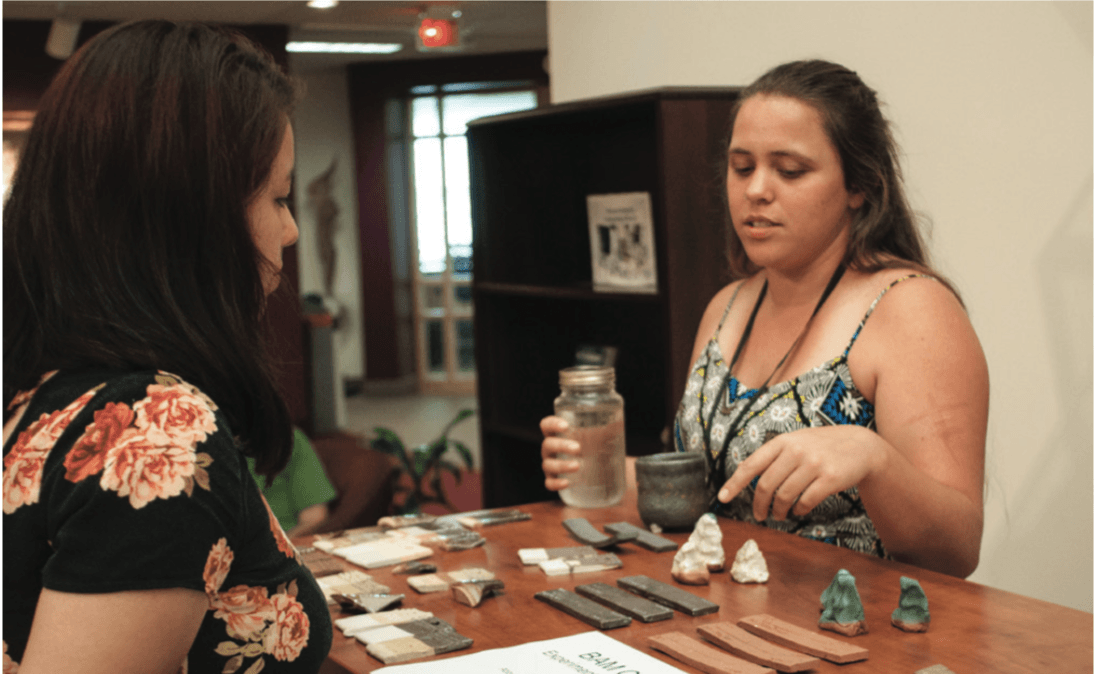Student presentations cover wide variety of subjects at the Guilford Undergraduate Symposium
Abby Horn ’17, right, presents her research to Lesly Vasquez ‘18, left, at the Guilford Undergraduate Symposium on Friday, April 21, 2017 at Guilford College in Greensboro, North Carolina.
Fish brains, music and memory, racial and economic divide in education, biofilms and LGBTQIA representation in STEM-related fields. These are just some of the many topics covered at the 2017 Guilford College Undergraduate Symposium.
On Friday, April 21, students and faculty members attended a multidisciplinary event, which included performances, creative works, original poetry, research presentations and panel discussions.
Many presenters discussed their research, focusing on either the natural or the social sciences. Junior Darby Kozan worked with gene expression in the interpeduncular nucleus of zebrafish.
“We’re studying the (habenulo-interpeduncular) pathway in the brain,” said Kozan. “A lot is known about the pathway, but very little is known about the target site that it goes through.
“What we wanted to do was categorize where populations of neurons are located in here. We ran RNA sequencing to see which genes are located in this section so we were able to synthesize RNA probes to go in and attach to the gene. It produces a polymeric reaction, which shows … where the gene is located.”
Senior Rohini Rajnarayanan plans to use a novel genetic modification technique known as CRISPR-Cas9 to deactivate a switch in a metabolic pathway of a highly drug-resistant bacteria.
“I’m looking at the Klebsiella pneumoniae,” said Rajnarayanan. “(It) is a gram-negative, capsulated, rod-shaped anaerobic bacterium normally found in the gut and the human nasal passage, but it can be spread through health care workers through their patients.
“That’s concerning because Klebsiella pneumoniae has recently been called multidrug-resistant and is now resistant to last resort antibiotics. What I want to do is find a new target for antibiotics to try to fight these pathogens.”
Rajnarayanan was not the only student who studied bacteria. Senior Kate Rich improved E. coli biosensors by changing their components.
“Our goal was to create a biosensor that detects E. coli in food and water sources,” said Rich. “The issue is to create that we have to use a base, and the one that was said in the literature was diisopropylethylamine. The base is incredibly corrosive. We had to wear two layers of gloves, do everything behind the glass, not touch anything. A drop still got on my gloves, and it burnt through both (pairs).
“We were looking to find (a base with a) similar pKa and steric hindrance to use instead of diisopropylethylamine. (The new base), triethylamine, was not only cheaper (and) less corrosive but also more efficient.”
Senior Taryn McFadden researched a method to disrupt dangerous biofilms with sound to allow antibiotics to better penetrate them.
“Biofilms are caused by biofouling or microbial aggregation on hydrated surfaces,” said McFadden. “It can be a single species forming the biofilm, or a complex biofilm from two species of bacteria, or bacteria and a fungus.
“There are multiple mechanisms of biofilm resistance. … One of the first is antibiotic resistance. Other benefits to microbes are quorum-sensing and resistance positive transfer. … Some studies have shown that a low frequency ultrasound in combination with antibiotics is able to disrupt the biofilm enough to allow antibiotics to enter and increase bactericidal activity.”
The symposium was not limited to natural science presentations. For example, senior Jonathan Goffredi presented on the relationship between academic achievement and wealth inequality in New York City.
“What really drew me to this topic was my experience growing up in public schools in Fayetteville, North Carolina,” said Goffredi. “What I saw in Fayetteville was inequitable schools that were segregated racially and economically.
“Last spring, I took a vacation up to New York City. … Neighborhoods and communities were aligned by race and ethnicity, as well as economic status. I looked at 32 postal districts in New York City. We measured academic competence, percentage of students in each district in poverty, percentage of teacher turnover, percentage of students with a learning disability, percentage of students learning English as a second language and percentage of black and Hispanic students.”
First-year Carrington Smith discussed her research regarding the lack of LGBTQIA representation in STEM-related fields.
“There are little to no statistics of the LGBT community in the STEM field,” said Smith. “People feel like they shouldn’t come out because they feel like their careers might be in jeopardy. There is a lack of support groups on campus. This community feels like it doesn’t have role models or (doesn’t) feel safe coming out.
“You rarely see representation when it comes to doctors or lawyers. You don’t see people who are lesbian or gay on TV who are doctors.”
The diversity of the symposium is reflected in the composition of the student presenters. Among the presenters were a few Early College students. Early College junior Sahana Giridharan presented her research on the effect of music in stimulating brain connectivity and episodic memory.
“I’m sure we all can think of a specific event when we’ve listened to a song in which we can think of something specific in our lives,” said Giridharan. “Multiple studies have found that music is the ideal stimulus to evoke episodic memory.
“The purpose of my study was to analyze the effects of preferred music on brain connectivity between the angular gyrus and the hippocampus. The implications of my research are understanding how the role of music as a stimulus in the memory formation process can help us use music as a diagnostic and preventative tool for patients with degenerative disorders.”
Other sessions included analyses of Guilford affairs, history presentations, psychology presentations, art presentations and many more.









